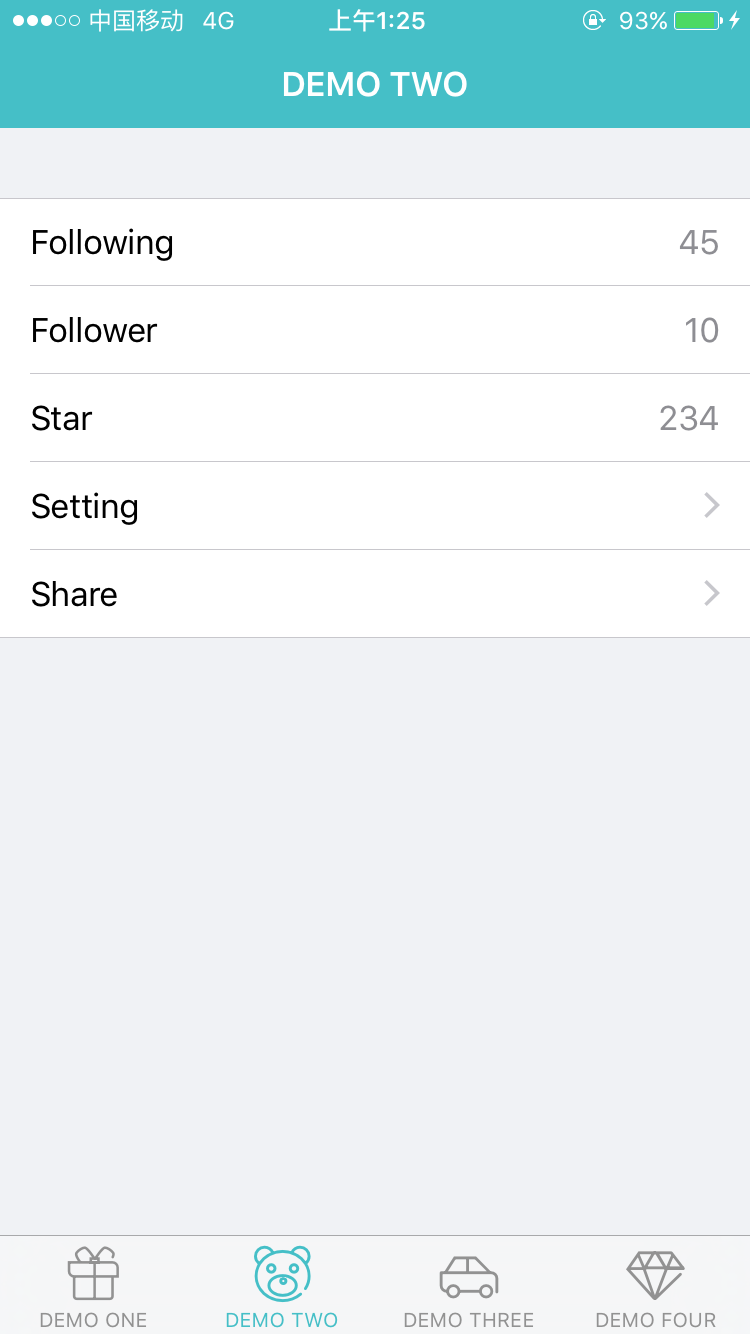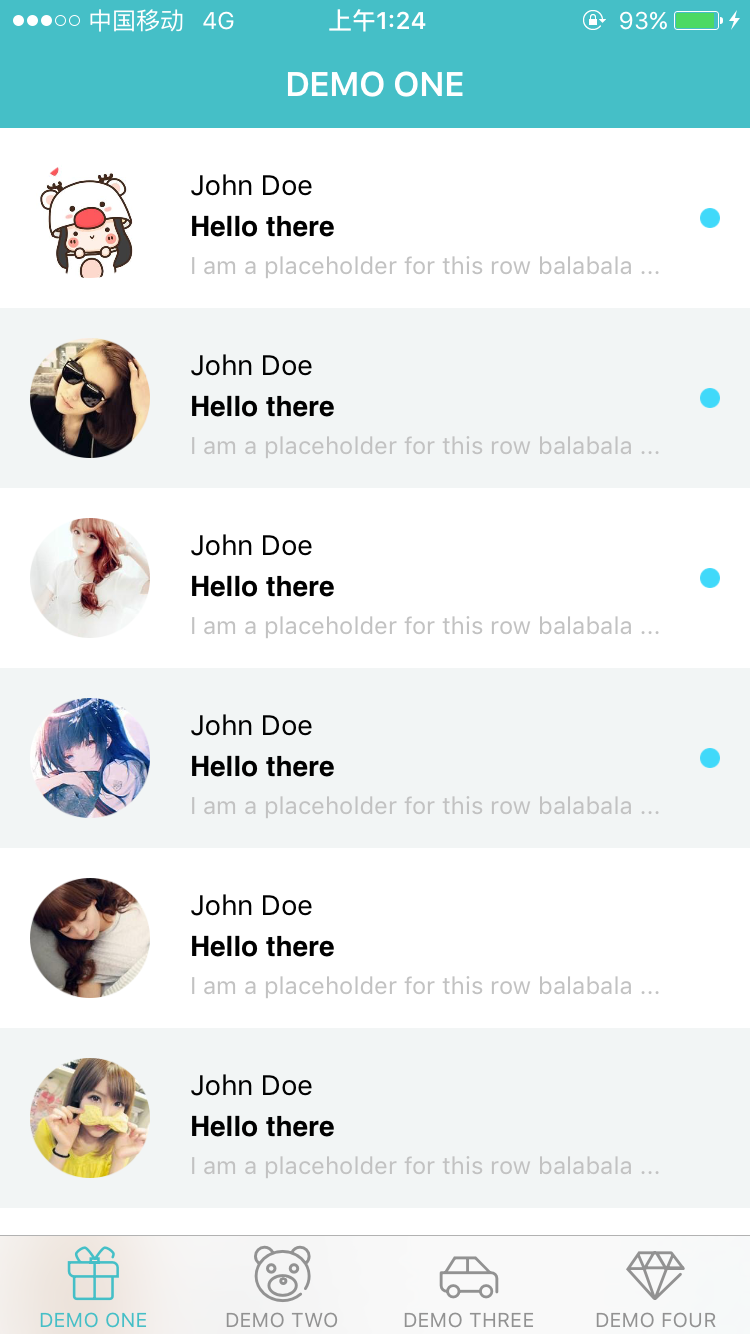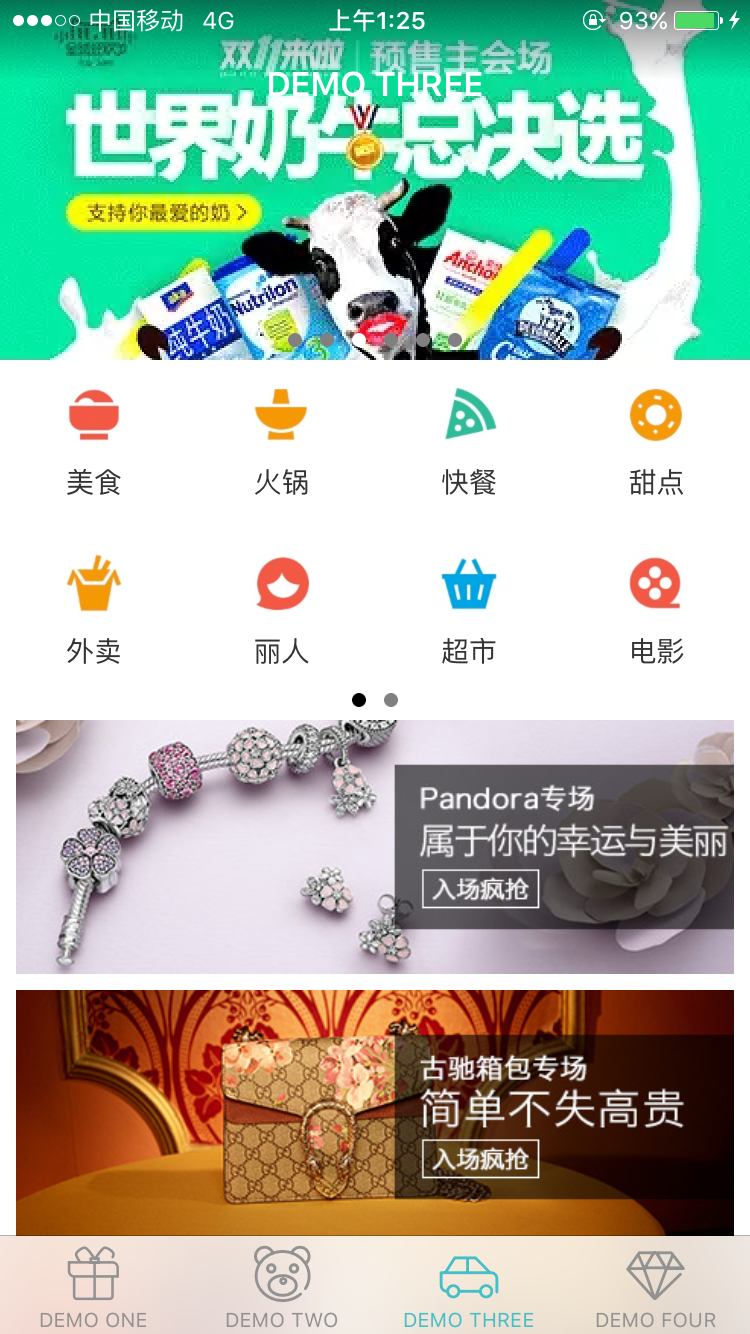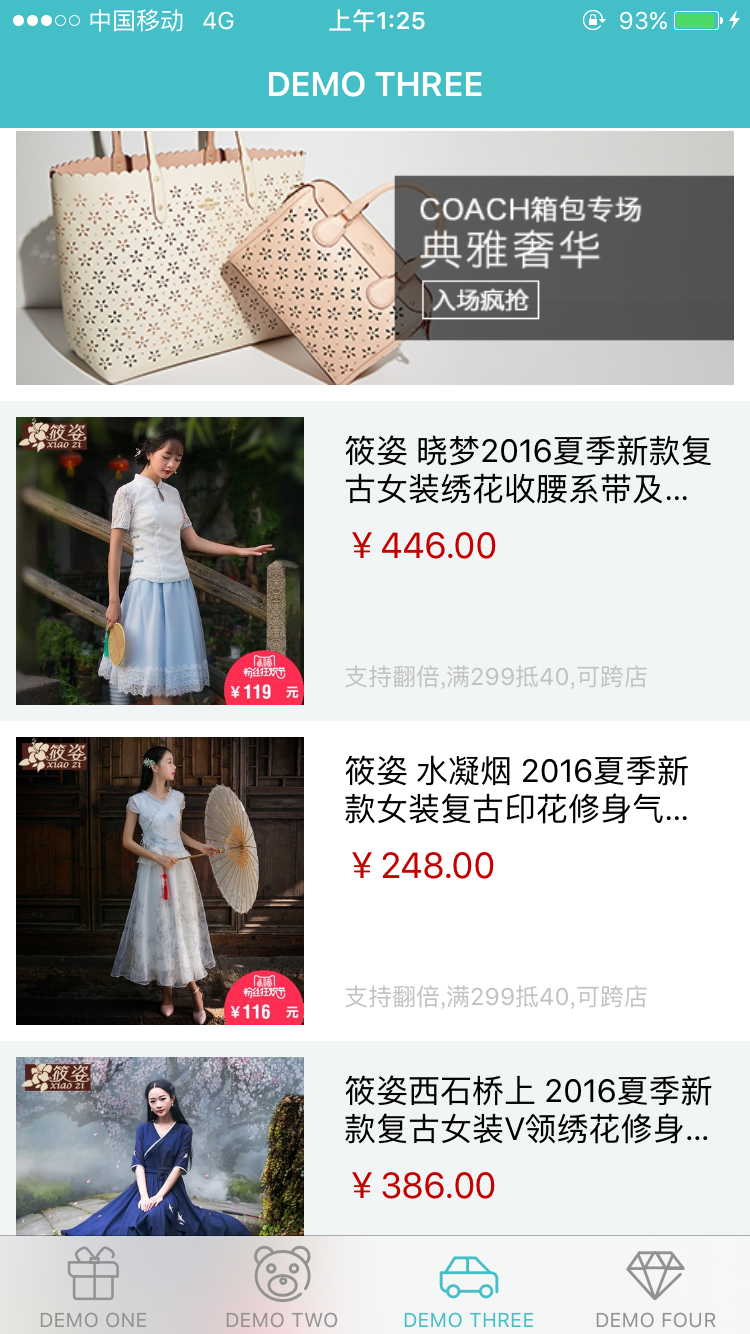CBTableViewDataSource 1.1.0
| TestsTested | ✗ |
| LangLanguage | Obj-CObjective C |
| License | MIT |
| ReleasedLast Release | Jun 2016 |
Maintained by cocbin.
CBTableViewDataSource 1.1.0
- By
- Cocbin
Just one line to create DataSource and Delegate for UITableView.
中文文档 (Document in Chinese)
Introduction
CBTableViewDataSource is a lightweight Framework which was used to create DataSource and Delegate for UITableView quickly. It provides a simple API to create logical and easily maintained code.
The most lazy way to create DataSource like this:
[_tableView cb_makeSectionWithData:self.viewModel.data andCellClass:[CustomCell class]];Of course, you must follow some convention in this way. At the same time, I also provides others flexible way to create DataSource.
Details as document below.
Why use
We always spend a lot of time and energy to create DataSource and Delegate for UITableView when we develop an App. While those code tend to repetitive and hard maintenance, because them located in each position of each delegate method. We must found them from corner to corner, and modified them when we maintain program.
However, CBTableViewDataSource changed all this, and provides a simple API to help us create logical and easily maintained code.
In order to make everyone notice advantages of this framework, let's do a compare.
Native way below:
// Native vision
// define a enum to split section
typedef NS_ENUM(NSInteger, SectionNameDefine) {
SECTION_ONE,
SECTION_TWO,
SECTION_THREE,
SECTION_FOUR,
//...
COUNT_OF_STORE_SECTION
};
// define identifier for section
#define IDENTIFIER_ONE @"IDENTIFIER_ONE"
#define IDENTIFIER_TWO @"IDENTIFIER_TWO"
#define IDENTIFIER_THREE @"IDENTIFIER_THREE"
#define IDENTIFIER_FOUR @"IDENTIFIER_FOUR"
//...
// register cell class for section
[self.tableView registerClass:[OneCell class] forCellWithReuseIdentifier:IDENTIFIER_ONE];
[self.tableView registerClass:[TwoCell class] forCellWithReuseIdentifier:IDENTIFIER_TWO];
[self.tableView registerClass:[ThreeCell class] forCellWithReuseIdentifier:IDENTIFIER_THREE];
[self.tableView registerClass:[FourCell class] forCellWithReuseIdentifier:IDENTIFIER_FOUR];
// implementation datasource protocol
- (NSInteger)numberOfSectionsInTableView:(UITableView *)tableView {
return COUNT_OF_STORE_SECTION;
}
- (NSInteger)tableView:(UITableView *)tableView numberOfRowsInSection:(NSInteger)section {
return ((NSArray*)self.data[section]).count;
}
- (UITableViewCell *)tableView:(UITableView *)tableView cellForRowAtIndexPath:(NSIndexPath *)indexPath {
NSUInteger section = (NSUInteger) indexPath.section;
NSUInteger index = (NSUInteger) indexPath.row;
switch(section) {
case SECTION_ONE:
// to do something
return cell;
case SECTION_TWO:
// to do something
return cell;
case SECTION_THREE:
// to do something
return cell;
//...
}
return cell;
}
// ...
It is cumbersome and hard maintenance in this way.
While using CBTableViewDataSource:
[_tableView cb_makeDataSource:^(CBTableViewDataSourceMaker * make) {
// section one
[make makeSection:^(CBTableViewSectionMaker *section) {
section.cell([OneCell class])
.data(self.viewModel.oneDate)
.adapter(^(OneCell * cell,id data,NSUInteger index){
[cell configure:data];
})
.autoHeight();
}];
// section two
[make makeSection:^(CBTableViewSectionMaker *section) {
section.cell([TwoCell class])
.data(self.viewModel.twoData)
.adapter(^(FeedCell * cell,id data,NSUInteger index){
[cell configure:data];
})
.autoHeight();
}];
// ... so on
}];It has been concise and layered. Most important is that it make codes accord with the man's thought better.
Usage
Install
using cocoapods:
pod 'CBTableViewDataSource'Import
#import <CBTableViewDataSource/CBTableViewDataSource.h>
Create DataSource and Delegate
[_tableView cb_makeDataSource:^(CBTableViewDataSourceMaker * make) {
// section one
[make makeSection:^(CBTableViewSectionMaker *section) {
section.cell([OneCell class])
.data(self.viewModel.oneDate)
.adapter(^(OneCell * cell,id data,NSUInteger index){
[cell configure:data];
})
.autoHeight();
}];
// section two
[make makeSection:^(CBTableViewSectionMaker *section) {
section.cell([TwoCell class])
.data(self.viewModel.twoData)
.adapter(^(FeedCell * cell,id data,NSUInteger index){
[cell configure:data];
})
.autoHeight();
}];
// ... so on
}];Example
Just using data
UITableView tableView = [UITableView new];
[tableView cb_makeSectionWithData:data];It will use default UITalbeViewCell as Cell Class in this way.
The data must follow convention as follows:
- data is a NSArray (NSArray < NSDictionary * >*).
-
The key of dictionary as follows:
-
textuse to set text forUITableViewCell's textLabel -
detailuse to set text forUITableViewCell's detailTextLabel -
valueuse to set text forUITableViewCell's detailTextLabel -
imageuse to set image forUITableViewCell's imageView -
accessoryTypeuse to set accessory type forUITableViewCell
valueanddetailboth be used to set text forUITableViewCell's detailTextLabel. If usedetailas key, thedetailTextLabelwill show at the bottom oftextLabel. If usevalueas key, thedetailTextLabelwill show at the right oftextLabel. Do not use both of them in the same time,and the first appear in array priority. -
For example:
_data = @[
@{@"text":@"Following",@"value":@"45"},
@{@"text":@"Follower",@"value":@"10"},
@{@"text":@"Star",@"value":@"234"},
@{@"text":@"Setting",@"accessoryType":@(UITableViewCellAccessoryDisclosureIndicator)},
@{@"text":@"Share",@"accessoryType":@(UITableViewCellAccessoryDisclosureIndicator)}];UI as follows:
Check detail on file named DemoTwoViewController.h and DemoTwoViewController.m.
Using custom cell
[tableView cb_makeSectionWithData:data andCellClass:[CustomCell class]];CustomCell must provides a Configuer: method or Configuer:index: method to adapt data.
For example:
- (void)configure:(NSDictionary *)row index:(NSNumber * )index {
if (row[@"avatar"]) {
[self.avatarView setImage:[UIImage imageNamed:row[@"avatar"]]];
} else {
[self.avatarView setImage:nil];
}
[self.nameLabel setText:row[@"name"]];
[self.titleLabel setText:row[@"title"]];
[self.detailLabel setText:row[@"detail"]];
self.circleView.hidden = row[@"unread"] == nil;
if([index intValue] &1) {
self.contentView.backgroundColor = [UIColor colorWithRed:0.95 green:0.96 blue:0.96 alpha:1.00];
} else {
self.contentView.backgroundColor = [UIColor whiteColor];
}
}Check detail on file named CustomCell.h and CustomCell.m
UI as follows:
Check detail on file named DemoOneViewController.h and DemoOneViewController.m.
More flexible setting
[tableView cb_makeSection:^(CBTableViewSectionMaker * section) {
section.data(@[]);
section.cell([CustomCell class]);
section.adapter(^(CustomCell cell,id row,NSUInteger index) {
cell.configure(row);
});
section.event(^() {
// do something
})
// other setting
}];Here show the case of single section.
CBTableViewSectionMaker
CBTableViewSectionMaker was used to setting some attribute for section.
Available attribute as follows :
data
Setting the data be used show in UITableView,argument was required a NSArray.
For example:
section.data(@[@(goods1),@(goods2),...]);cell
Setting the Cell Class which was used to show data.
The identifier of cell will be register automatically.
For example:
section.cell([CustomCell class]);adapter
Was used to adapt cell and date.
For example:
section.adapter(^(CustomCell * cell,id row,NSUInteger index) {
[cell configure:row];
// ...
});
event
Was used to setting event when cell be touch, for example:
section.event(^(NSUInteger index,id row) {
CustomViewController * controller = [CustomViewController new];
controller.viewModel.data = row;
[self.navigationController pushViewController:controller animated:YES];
});height
Used to setting height for cell. Is required a static value.
This height just vail for current section.
section.height(100);autoHeight
Used to setting dynamic calculate height for cell.
section.autoHeight();If has setting autoHeight,the height will be invalid.
headerTitle;
Used to setting header title for section. For example:
section.headerTitle("title");footerTitle;
Used to setting footer title for section. ditto.
headerView;
Used to setting header view for section. For example
section.headerView(^(){
UIView * headerView = [UIView alloc]initWithFrame:CGRectMake(0,0,320,40);
// ...
return headerView;
})If has setting headerView,headerTitle will be invalid.
footerView;
Used to setting footer view for section. ditto.
Multiple Section
[tableView cb_makeDataSource:^(CBTableViewDataSourceMaker * make) {
[make headerView:^{
return [HeaderView new];
}];
[make makeSection: ^(CBTableViewSectionMaker * section) {
section.data(@[]);
section.cell();
section.adapter();
section.event();
// ... so on
}];
[make makeSection: ^(CBTableViewSectionMaker * section) {
section.data(@[]);
section.cell();
section.adapter();
section.event();
// ... so on
}];
[make makeSection: ^(CBTableViewSectionMaker * section) {
section.data(@[]);
section.cell();
section.adapter();
section.event();
// ... so on
}];
// .. so on
[make footView:^{
return [FooterView new];
}];
}]UI as follows:
Check detail on file named DemoThreeViewController.h and DemoThreeViewController.m.
CBTableViewDataSourceMaker
CBTableViewDataSourceMaker was used to setting some attribute for UITableView.
Available attribute as follows :
makeSection
Used to add a section for UITableView.For example:
[tableView cb_makeDataSource:^(CBTableViewDataSourceMaker * make) {
[make makeSection: ^(CBTableViewSectionMaker * section) {
// ...
}
}]height
Used to setting default height for UITableView
make.height(100);If you had setting height or autoHeight for section, the height of here will invalid. Default is 40.
headerView
Used to setting tableHeaderView for UITableView.Notice the difference between tableHeaderView and section‘s headerView.
For example:
make.headerView(^(){
UIView * headerView = [[UIView alloc]init];
// ...
return headerView;
});footerView
Used to setting tableFooterView for UITableView. ditto.
commitEditing
Used to setting commitEditing method for UITableViewDelegate.
[make commitEditing:^(UITableView * tableView, UITableViewCellEditingStyle * editingStyle, NSIndexPath * indexPath) {
// do somethings.
}];scrollViewDidScroll
Used to setting scrollViewDidScroll method for UITableViewDelegate
[make scrollViewDidScroll:^(UIScrollView * scrollView) {
// do somethings
}];Thinks
Thank you for using and supporting. Welcome to issue and pull request. I will deal with at first time.
I refer to many masters in this framework. For example, I refer to famous autolayout framework Masonary when I design API. The way to dynamic calculate cell height is refer to @forkingdog's UITableView-FDTemplateLayoutCell.
Thinks them for bring inspiration to me.
Contact me by email :[email protected]




